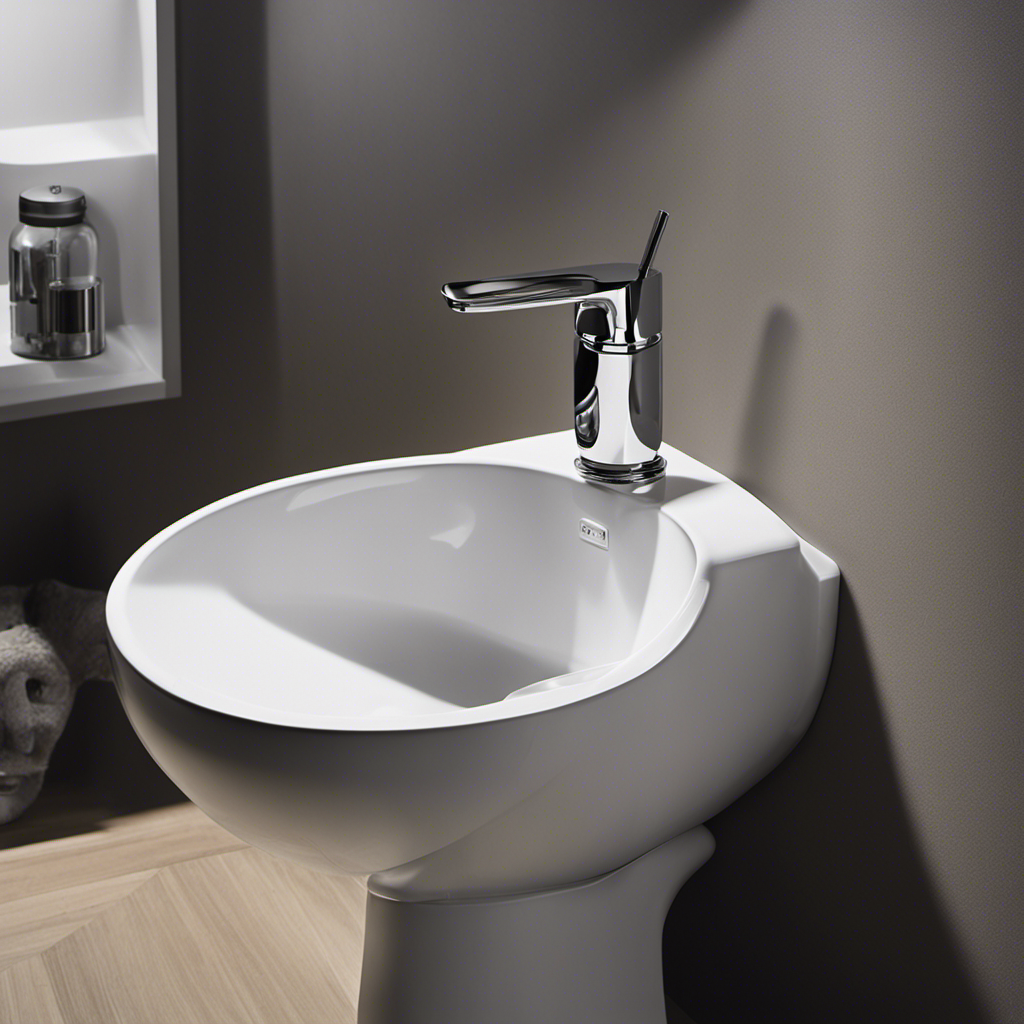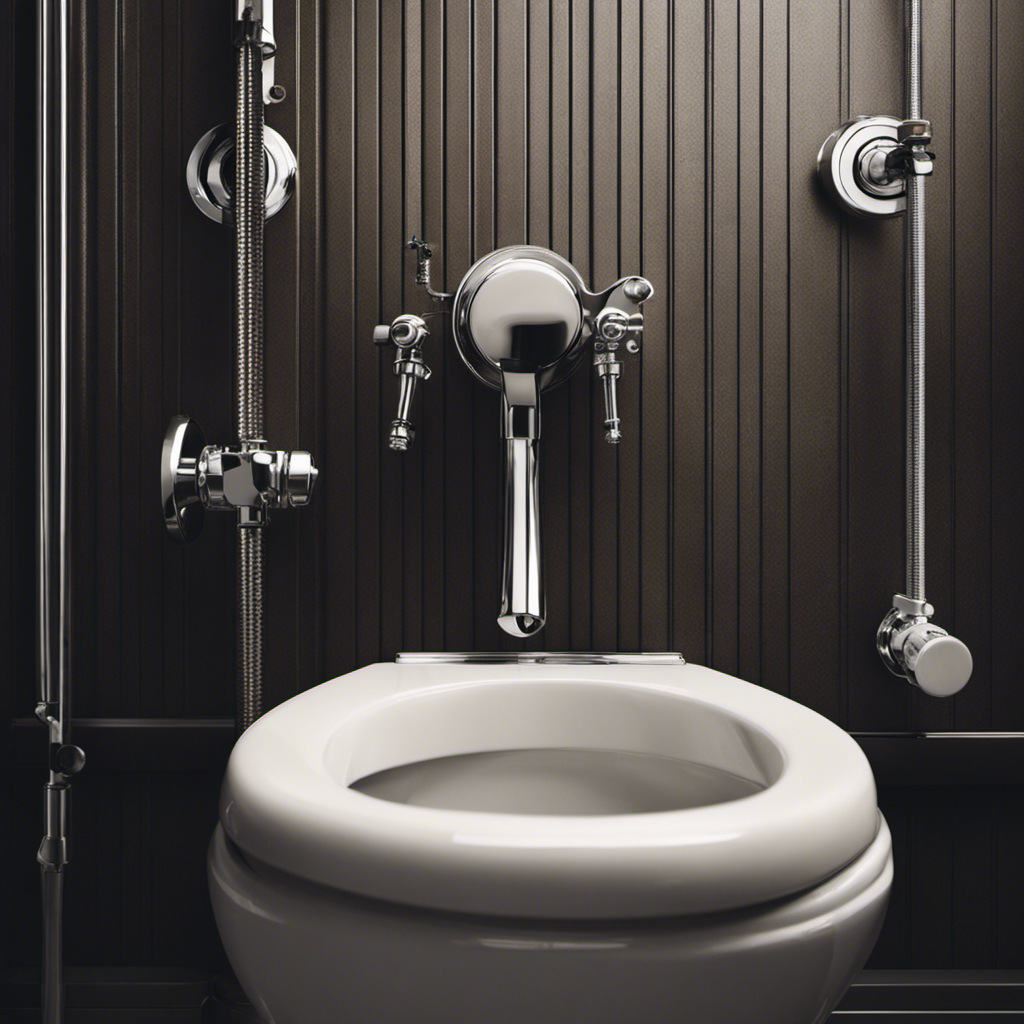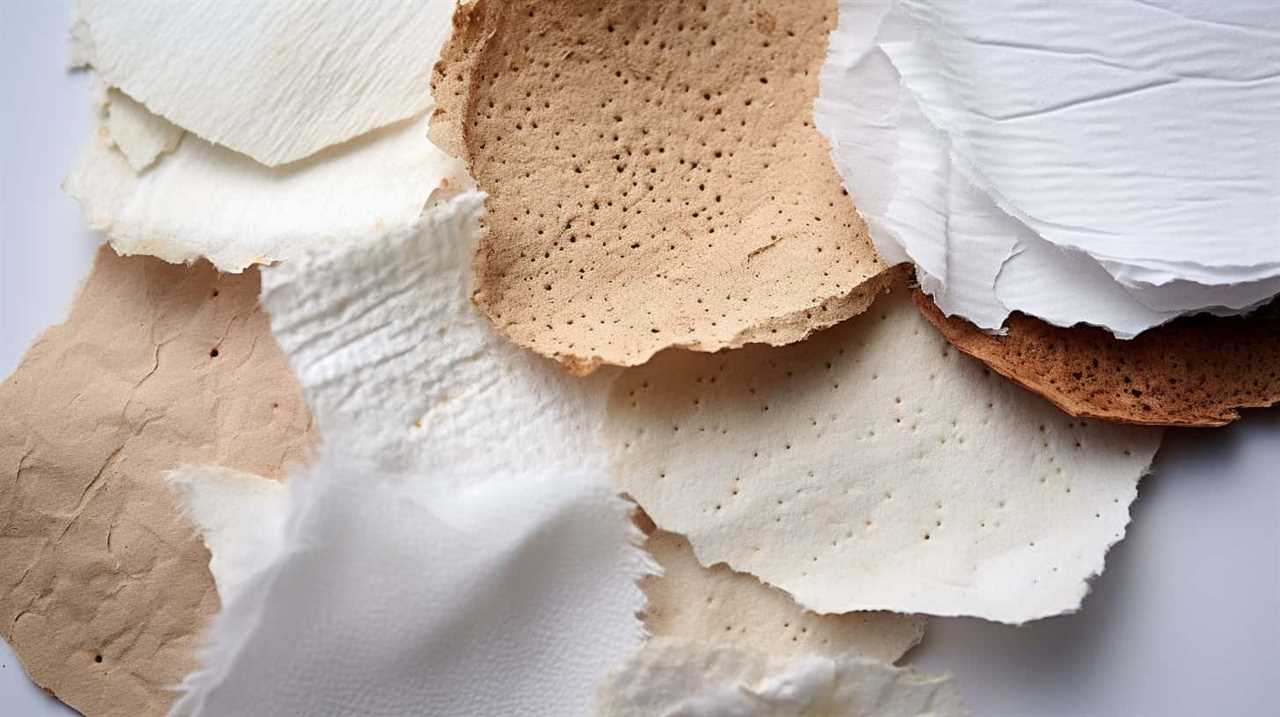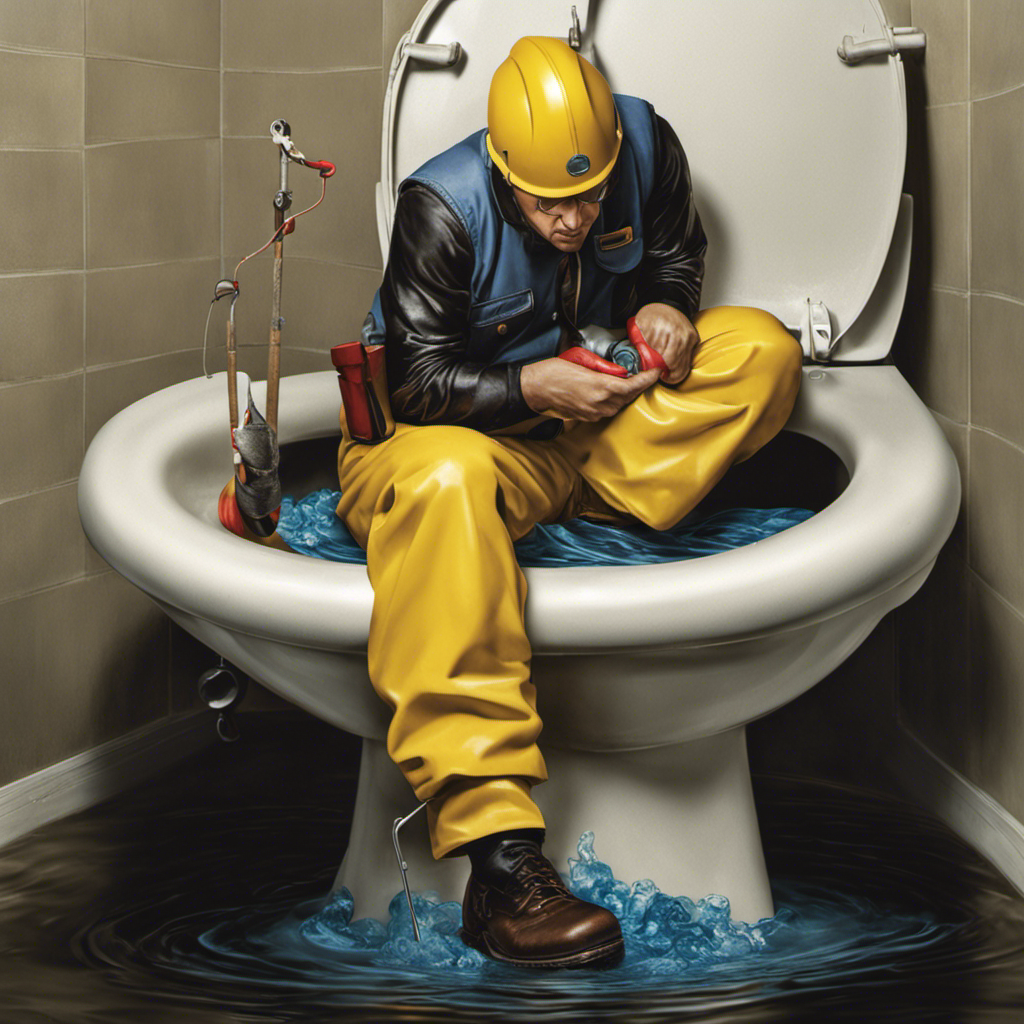So, you’re in a bit of a pickle and need to turn off the water supply to your toilet? No worries, we’ve got you covered!
In this article, we’ll walk you through the simple steps to locate and manipulate the shut-off valve, ensuring a smooth and hassle-free process.
By following our expert instructions, you’ll be able to confidently shut off the water supply and tackle any toilet-related issues with ease.
Let’s get started, shall we?
Key Takeaways
- The shut-off valve is usually located behind the toilet, near the floor.
- Turning the shut-off valve clockwise stops the water supply to the toilet.
- If the shut-off valve is not working properly, alternatives to consider are the main water supply cutoff, individual fixture shutoffs, or the water meter valve.
- Empty the toilet tank by turning off the water supply and flushing multiple times.
Locating the Shut-off Valve
The shut-off valve is usually located behind the toilet, near the floor. To locate the valve handle, you need to look for a small metal or plastic lever or wheel. It is usually connected to a pipe that is attached to the wall. The valve handle may be round or lever-shaped, depending on the type of valve installed.
Once you have located the valve handle, you can proceed to shut off the water flow to the toilet. This is an important step in case of emergencies or when performing repairs.
Now that you know where the shut-off valve is located, let’s move on to the next step of turning the shut-off valve clockwise to stop the water supply to the toilet.
Turning the Shut-off Valve Clockwise
To stop the water supply to your toilet, you will need to locate and turn off the shut-off valve. The shut-off valve is typically located near the base of the toilet or on the wall behind it.
To shut off the water, simply turn the valve clockwise until it is fully closed.
Clockwise Shut-Off Valve
You can easily turn off the water supply to the toilet by simply turning the clockwise shut-off valve. This valve is usually located near the base of the toilet, either on the wall or on the floor. By turning it clockwise, you will close the valve and stop the water flow to the toilet. This is a simple and effective way to perform maintenance tasks such as repairing a leaky toilet or replacing parts. However, if you find that the shut-off valve is not working properly or if you need an alternative solution, here are some options to consider:
| Shut-off Valve Alternatives |
|---|
| 1. Main Water Supply Cutoff |
| 2. Individual Fixture Shutoffs |
| 3. Water Meter Valve |
These alternatives can be used in case the clockwise shut-off valve is not functioning or if you need to turn off the water supply to specific areas without affecting the rest of the house. It’s always a good idea to familiarize yourself with these alternatives to ensure you can quickly and effectively turn off the water supply when needed.
Stopping Toilet Water Supply
By simply twisting the clockwise shut-off valve, you can easily halt the flow of water to the toilet. This valve is usually located behind the toilet, near the wall. It is a small lever that can be turned with your hand.
When you turn it clockwise, the valve closes and stops the water flow. This is a useful technique in case of emergencies, such as a leaking toilet or a broken pipe. By shutting off the water source, you can prevent any further damage and buy yourself some time until a professional plumber arrives.
Remember to turn off the valve completely to ensure that no water is still flowing to the toilet.
Now that you know how to stop the water flow, let’s move on to the next step of shutting off the water completely.
Shutting off Water
Now that you’ve successfully stopped the water flow, it’s time to shut off the main water supply to your house. This step is crucial in preventing any further water damage or leaks.
To ensure a smooth process, follow these steps:
- Locate the main water shut-off valve: It is usually located near the water meter, which is typically found in the basement, crawl space, or near the water heater.
- Turn off the valve: Use a wrench or pliers to turn the valve clockwise until it is fully closed. This will effectively shut off the water supply to your entire house.
Finding alternative solutions and troubleshooting water shut off can be challenging in certain situations. If you encounter any difficulties or if the main shut-off valve is not functioning properly, it is recommended to consult a professional plumber who can provide expert assistance.
Confirming the Water Supply Is off
Make sure the water supply has been turned off before proceeding. To confirm that there is no water leak, check the water pressure in the toilet.
Start by lifting the toilet tank lid and locating the water shut-off valve. It is usually located on the wall behind the toilet or under the tank. Turn the valve clockwise until it stops to shut off the water supply.
Now, flush the toilet by pressing down on the flush handle. If no water refills the tank, it means the water supply has been successfully turned off. If water still fills the tank, double-check the shut-off valve and make sure it is fully closed.
Once you have confirmed the water supply is off, you can proceed to the next step of flushing the toilet to remove the water.
Flushing the Toilet to Remove Water
To empty toilet water quickly and prevent water damage effectively, there are a few key points to keep in mind.
Firstly, make sure to locate and use the shut-off valve to stop the flow of water into the toilet.
Next, flush the toilet to remove as much water as possible from the bowl.
Finally, use a plunger or a wet/dry vacuum to eliminate any remaining water from the toilet and surrounding area.
Emptying Toilet Water Quickly
If you want to empty the toilet water quickly, you can use a bucket to scoop it out. Here’s how you can do it:
-
Start by turning off the water supply to the toilet. This will prevent any more water from filling the bowl or tank.
-
Next, flush the toilet to remove as much water as possible from the bowl. You can do this by pressing down on the flush handle or lever.
-
Once the bowl is empty, use a bucket to scoop out the remaining water. Make sure to wear gloves and be careful not to spill any water on the floor.
-
After emptying the toilet bowl, you can also remove the water from the tank. This can be done by using a sponge or towel to soak up the water or by using a wet/dry vacuum.
By following these steps, you can quickly and effectively empty the toilet water.
Now, let’s move on to the next section about preventing water damage effectively.
Preventing Water Damage Effectively
One effective way to prevent water damage is by regularly inspecting and maintaining your plumbing system. Proper water supply management is crucial in preventing water damage in your home.
Regularly check for any leaks or drips in your faucets, pipes, and toilets. Repair or replace any faulty components immediately to avoid water damage. Inspect the water supply lines for any signs of wear or damage, and replace them if necessary.
It is also important to ensure that your gutters and downspouts are clean and free from debris, as clogged gutters can cause water to overflow and seep into your home. Additionally, consider installing water detection devices and shut-off valves to quickly identify and stop water leaks.
Emptying the Toilet Tank Completely
You can completely empty the toilet tank by turning off the water supply and flushing the toilet multiple times. This is an efficient way to minimize water usage while still ensuring that the tank is completely empty.
Here are some tips to help you empty the toilet tank efficiently:
-
Turn off the water supply valve located behind the toilet. This will stop the flow of water into the tank.
-
Flush the toilet once to drain out any remaining water in the tank.
-
Wait for a few minutes to allow any residual water to drain out completely.
-
Flush the toilet again to ensure that all the water has been emptied from the tank.
-
Repeat this process if necessary, until no more water comes out when you flush.
Securing the Shut-off Valve in the Off Position
Now that you have successfully emptied the toilet tank, it is time to secure the shut-off valve in the off position. This step is crucial to ensure that no water flows into the toilet while you work on it.
Locate the shut-off valve, which is usually located behind the toilet near the floor. Turn the valve handle clockwise until it is fully closed. This will stop the flow of water to the toilet. It is important to make sure the valve handle is secured tightly in the off position to prevent any water from leaking.
Once the valve is closed, you can proceed to disconnect the water line from the toilet tank. This will allow you to further work on the toilet without any water interference.
Conclusion
Now that you know how to turn off the water supply to your toilet, you hold the power to control the flow of life.
Just like the shut-off valve, you have the ability to pause, to reflect, and to make necessary adjustments.
By taking charge of the water supply, you are taking charge of your own destiny.
Remember, in the grand symphony of life, you are the conductor, guiding the rhythm and harmony of your own existence.
Embrace this newfound knowledge and let it empower you to navigate the currents of life with confidence and grace.










